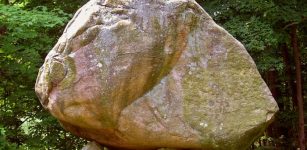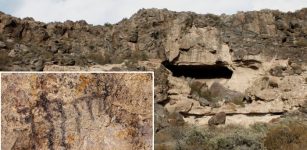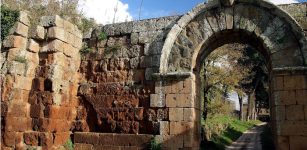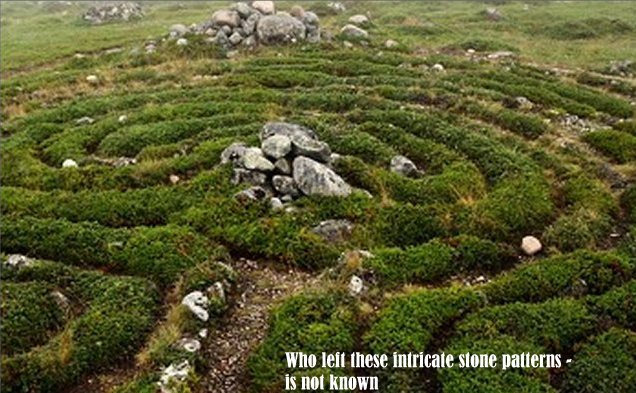Secrets Of Bolshoi Zayatsky Island – Mysterious Stone Labyrinths Of Unknown Purpose And Origin
A. Sutherland - AncientPages.com - One of the most isolated and mystical places of the northern region, is the Solovetsky Archipelago that comprises six islands in the western part of the White Sea, of Russia's Far North. Traces of a human presence from as far back as the 5000 B.C. can be found on these islands covering 300 square kilometers, but about the oldest inhabitants of the islands, very little is known.
Particularly interesting is the Bolshoi Zayatsky (Big Zayatsky) Island dated to the 3rd millennium BC and once occupied by prehistoric residents who built sacred sites, villages, and irrigation systems. However, not much is known about their life, beliefs, and religious rituals.
Today the site is sparsely populated and people live a simple life, but the Bolshoi Zayatsky - with a large number of ancient stone mazes - has been attracting scientists and enthusiasts for many years with its mysteries.
The Bolshoi Zayatsky island makes it stand out among the many similar empty northern islands.
It is believed that the mysterious people of Bolshoi Zayatsky, left a group of 13 – 14 stone labyrinths on 0.4 km 2 area of one small island, as many as 850 heaps of boulders containing bones, a great variety of petroglyphs, and many places of worship.
Anzer Island, for example, which is also a part of the Solovetsky Archipelago, has only four labyrinths and 38 cairns, disposed in three irregular rows along the seashore.
Totally, on the Solovetsky Islands, there have been preserved more than 30 stone labyrinths.
For some reason, the intricate patterns of stones, scattered around the Big Zayatsky island appeared in the distant past.
Several theories have been proposed to explain the labyrinths' true purpose.
According to one theory, supported by the argument that almost all the mazes are located on the coast, their creators were the northern seafarers exploring the cold realm of waters today known as White Sea.
Another suggestion is that they may have represented a border between this world and the underworld.
Could the formations be related to the spiritual beliefs of the ancient inhabitants of Bolshoi Zayatsky and even another small island of the archipelago?
Professor Alexander Kuratov, one of the researchers who investigated the formations, says that
"... labyrinths on the Solovetsky Islands are the spiral-shaped figures, it is a system of tangled passages, walls of which are laid out with boulders. Near 30 labyrinths of different size and form were discovered on the Solovetsky Islands during the last 100 years of research.
Spiral that twists from left to right or from right to left is a foundation of most labyrinths. The “Horse Shoe” shape of the labyrinths depends on how many twists spiral has and on principal of the way it untwists with further transformation of its constitution. The amount of “horse shoes” formed by spiral and additional elements of construction provide different degrees figure complexity.
Labyrinths are not very tall – about 40 centimeters high, they are often located on the ground right by the sea and covered with lichen, moss, heather, and small bushes. Labyrinths have no distinct orientation, their exits-entrances are pointed to south-east, south, south-west and west, most of the times to the sea.
Labyrinths could be used not only as burial grounds for the tribes that lived along the White Sea, but for the tribal rituals as well..." (A. Martynov, “Ancient trails of Solovetsky Islands”)
All the labyrinths on Bolshoi Zayatsky were built with boulders gathered locally, and are concentrated on the western side of the island, while its eastern part is covered by a large collection of stone formations, of which many depict the sun with radial spokes.
The age of labyrinths is estimated to approximately 3000 BC but they can be much older.
Both very large and small designs of boulders vary in size and pattern, but most of them represent a single or double helix maze that has only one entrance, which is at the same time exit point. The smallest labyrinth measures around six meters in diameter with the largest being 25.4 meters in diameter.
The rows of boulders form spirals, with some consisting of two spirals, described as resembling two serpents with their heads in the center. The entrances to the labyrinths are mostly on the south and while there are five different settings, they each have only one entrance/exit point.
There may be many different theories and speculations but still, how, when, and for what purpose the island's stone formations were created - are questions that remain unanswered by researchers.
The Bolshoi Zayatsky's labyrinths - continue to remain a mystery.
Written by – A. Sutherland AncientPages.com Staff Writer
Copyright © AncientPages.com All rights reserved. This material may not be published, broadcast, rewritten or redistributed in whole or part without the express written permission of AncientPages.com
UNESCO
https://whc.unesco.org/en/list/632/
Wikipedia
More From Ancient Pages
-
 Ignored Archaeological Discovery At Puma Punku That Could Re-Write Ancient History
Featured Stories | May 11, 2020
Ignored Archaeological Discovery At Puma Punku That Could Re-Write Ancient History
Featured Stories | May 11, 2020 -
 Mystery Of Doppelgangers And Spirit Doubles – From Ancient To Modern Times
Featured Stories | Sep 16, 2014
Mystery Of Doppelgangers And Spirit Doubles – From Ancient To Modern Times
Featured Stories | Sep 16, 2014 -
 Ancient City Of Aizanoi: Statue Heads Of Greek Gods Unearthed In Excavations
Archaeology | Nov 23, 2021
Ancient City Of Aizanoi: Statue Heads Of Greek Gods Unearthed In Excavations
Archaeology | Nov 23, 2021 -
 During Tough Times Ancient ‘Tourists’ Sought Solace In Florida Oyster Feasts
Archaeology | May 4, 2020
During Tough Times Ancient ‘Tourists’ Sought Solace In Florida Oyster Feasts
Archaeology | May 4, 2020 -
 Facial Reconstruction Of 3.8-Million-Year-Old Skull Shows What Our Ancestors Really Looked Like
Archaeology | Dec 29, 2022
Facial Reconstruction Of 3.8-Million-Year-Old Skull Shows What Our Ancestors Really Looked Like
Archaeology | Dec 29, 2022 -
 Incredibly Well-Preserved Viking Age Ski Discovered Under Melting Ice
Archaeology | Nov 8, 2022
Incredibly Well-Preserved Viking Age Ski Discovered Under Melting Ice
Archaeology | Nov 8, 2022 -
 Runes Were Just As Advanced As Roman Alphabet Writing – New Study
Archaeology | Mar 3, 2023
Runes Were Just As Advanced As Roman Alphabet Writing – New Study
Archaeology | Mar 3, 2023 -
 10 Aztec Symbols Explained
Ancient Symbols | Mar 20, 2018
10 Aztec Symbols Explained
Ancient Symbols | Mar 20, 2018 -
 Mystery Of The Giant Boulder In North Salem
Featured Stories | Aug 8, 2019
Mystery Of The Giant Boulder In North Salem
Featured Stories | Aug 8, 2019 -
![Photo taken on Dec 20, 2015 shows hoof-shaped gold ware unearthed from the main coffin in the Haihunhou (Marquis of Haihun) cemetery, East China's Jiangxi province. [Photo/Xinhua]](https://www.ancientpages.com/wp-content/uploads/2015/12/MarquisofHaihuntomb1-307x150.jpg) Does A 2,000-Year-Old Tomb Belong To Marquis of Haihun? – Search For His Seal Continues
Archaeology | Dec 25, 2015
Does A 2,000-Year-Old Tomb Belong To Marquis of Haihun? – Search For His Seal Continues
Archaeology | Dec 25, 2015 -
 Prince John’s Plot Against King Richard The Lionheart
Featured Stories | Nov 20, 2018
Prince John’s Plot Against King Richard The Lionheart
Featured Stories | Nov 20, 2018 -
 Who Were The Sin Eaters?
Ancient History Facts | Jan 21, 2020
Who Were The Sin Eaters?
Ancient History Facts | Jan 21, 2020 -
 Puzzling Comb Drawing In Huenul Cave May Be The Oldest Rock Art In South America
Archaeology | Feb 15, 2024
Puzzling Comb Drawing In Huenul Cave May Be The Oldest Rock Art In South America
Archaeology | Feb 15, 2024 -
 Sacred City Of Caral – Site Of The Oldest Known Civilization In The Americas
Civilizations | Aug 28, 2018
Sacred City Of Caral – Site Of The Oldest Known Civilization In The Americas
Civilizations | Aug 28, 2018 -
 Chain Mail Reveals Roman Soldiers Recycled And Repaired Their Own Armor
Archaeology | Dec 12, 2024
Chain Mail Reveals Roman Soldiers Recycled And Repaired Their Own Armor
Archaeology | Dec 12, 2024 -
 Surprising End To Legend Of The Snallygaster That Terrorized Maryland And Washington
Featured Stories | Jun 1, 2020
Surprising End To Legend Of The Snallygaster That Terrorized Maryland And Washington
Featured Stories | Jun 1, 2020 -
 Mysterious Disappearance Of Philip Christoph Königsmarck – Where Is The Swedish Count Buried?
Featured Stories | Feb 21, 2024
Mysterious Disappearance Of Philip Christoph Königsmarck – Where Is The Swedish Count Buried?
Featured Stories | Feb 21, 2024 -
 Ullr – Famous Norse Archer – God Of Asgard And Fastest Skier Ever Known Who Taught People The Art
Featured Stories | Jan 10, 2020
Ullr – Famous Norse Archer – God Of Asgard And Fastest Skier Ever Known Who Taught People The Art
Featured Stories | Jan 10, 2020 -
 Summer Solstice Festivals Around The World – Midsummer Celebration Is An Ancient Tradition Still Alive
Ancient Traditions And Customs | Jun 21, 2024
Summer Solstice Festivals Around The World – Midsummer Celebration Is An Ancient Tradition Still Alive
Ancient Traditions And Customs | Jun 21, 2024 -
 New Clues About The Fascinating Ancient Roman City Falerii Novi Revealed By Scientists
Archaeology | Sep 13, 2022
New Clues About The Fascinating Ancient Roman City Falerii Novi Revealed By Scientists
Archaeology | Sep 13, 2022





